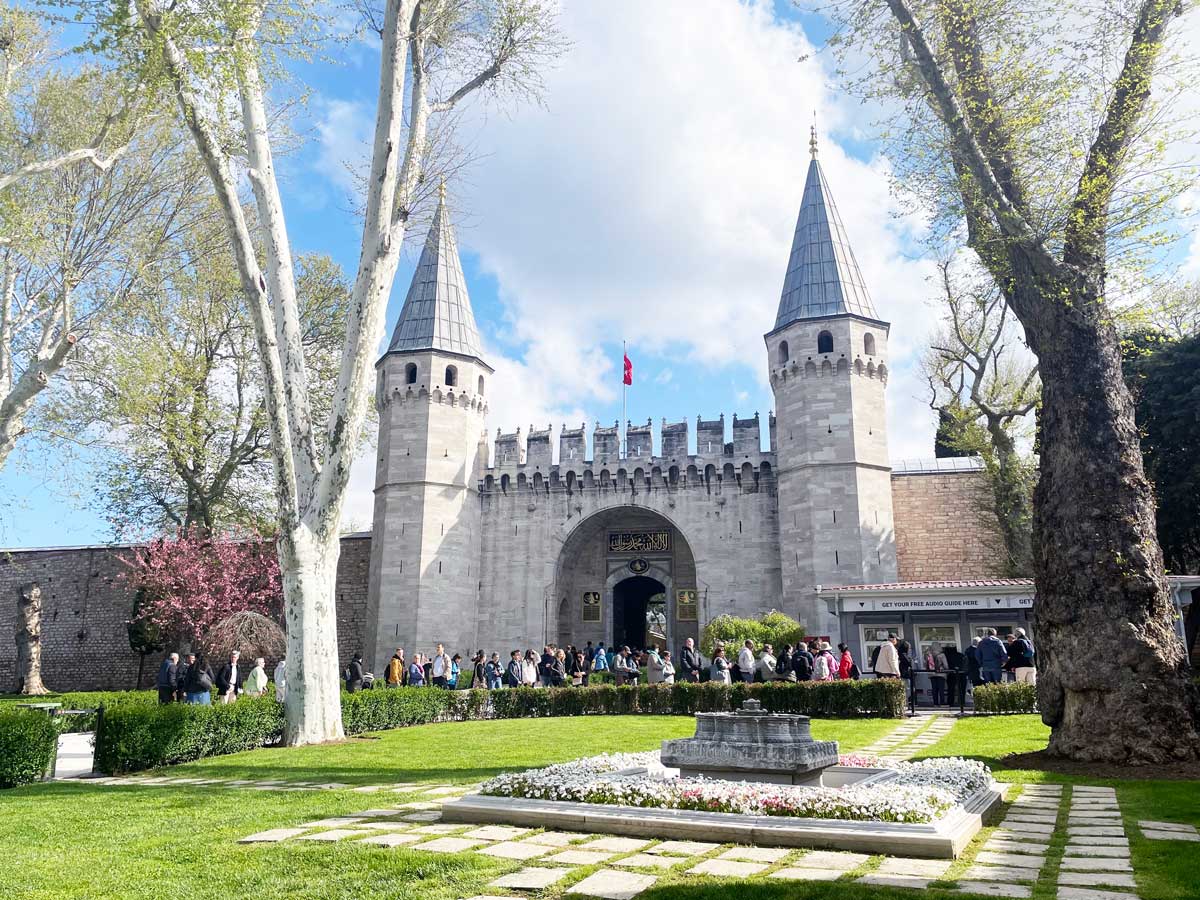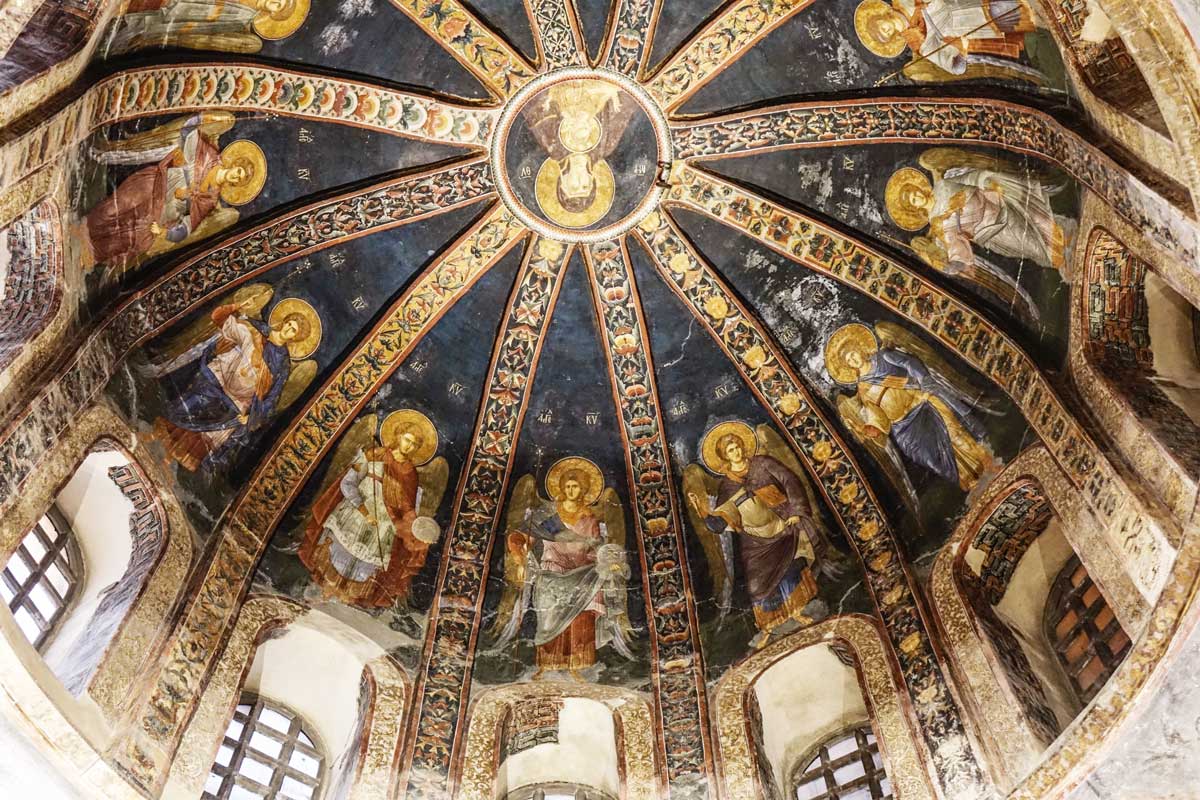Situated at the crossroads of Europe and Asia, Istanbul has served as the capital of three mighty empires: Roman, Byzantine, and Ottoman.
Top historical sights in Istanbul
Istanbul is a treasure trove of historical significance, with mosques, museums, monuments, and palaces scattered throughout its vibrant streets. Immerse yourself in the rich history of this city by exploring our curated list of the best historic places in Istanbul.
Hagia Sophia (Ayasofya)

Location: Sultanahmet
One of the most famous historical landmarks in Istanbul. Originally built as a Christian cathedral in the 6th century (537 AD), it was later converted into a mosque during the Ottoman Empire. In 1935 the building was converted from a mosque to a museum. However, in 2020, it was once again made a mosque. This is why today you can enter for free!
The Hagia Sophia is a stunning blend of Christian and Islamic styles, with a massive dome that dominates the interior. The intricate mosaics and frescoes that cover the walls and ceilings are a testament to the skill of the artists who created them.
The Blue Mosque (Sultan Ahmet Mosque)

Location: Sultanahmet
Opposite the Hagia Sophia is the Sultanahmet Mosque, also known as the Blue Mosque. It is a stunning example of Ottoman architecture and is one of the best historic sites to see in Istanbul. Located in the heart of Sultanahmet, the mosque was built in the early 17th century during the reign of Sultan Ahmet I.
The mosque is renowned for its striking blue tiles, which adorn the interior walls and give the mosque its nickname. The tiles were handmade in Iznik, a small town in western Turkey known for its ceramics. The mosque’s interior also features intricate calligraphy and towering columns, creating a sense of grandeur and awe.
Topkapi Palace

Location: Sultanahmet
Topkapi Palace is a must-see historical place in Istanbul that was once the residence of Ottoman Sultans for nearly 400 years. It is a vast complex of buildings and gardens that offer visitors a glimpse into the opulent lifestyle of the Ottoman Empire.
One of the highlights of Topkapi Palace is the Imperial Treasury, which houses a vast collection of priceless artifacts. Visitors can see the famous Topkapi Dagger, a jeweled masterpiece that is considered one of the most valuable weapons in the world. Other treasures on display include the Spoonmaker’s Diamond, a massive 86-carat diamond that was discovered in the 17th century.
Another fascinating part of Topkapi Palace is the Harem which were once the private quarters of the Sultan and his family. Visitors can explore the beautiful courtyards, ornate rooms, and intricate tilework that make up this section of the palace. It is a fascinating glimpse into the lives of the Ottoman elite.
Basilica Cistern

Location: Sultanahmet
The Basilica Cistern, located just 150m from Hagia Sophia, is a unique historical site. Built in the 6th century, during the Byzantine Empire, this underground water reservoir was used to supply water to the Great Palace of Constantinople and other important buildings in the city.
The cistern is an impressive engineering feat, with a capacity of over 80,000 cubic meters of water. It is supported by 336 columns, some of which are carved with intricate designs. Visitors can walk on raised platforms above the water and admire the columns and arches that make up this fascinating structure.
One of the most interesting features of the Basilica Cistern is the two Medusa heads that are used as column bases. These ancient relics are believed to have been brought from a pagan temple and have been incorporated into the cistern’s design. It’s a good place to visit to escape the weather.
Istanbul Archaeology Museum

Location: Sultanahmet
The Istanbul Archaeology Museum is a complex of three museums located behind the Hagia Sophia and next to Topkapi Palace. The museums are among the most important historical museums in Turkey. They house a vast collection of artifacts from various civilizations, including the Ottoman Empire, ancient Greece, Rome, and Egypt.
The Museum of the Ancient Orient is one of the three museums in the complex. It houses a collection of artifacts from the ancient Near East, including Sumerian, Babylonian, Assyrian, and Hittite artifacts. The museum’s collection includes cuneiform tablets, cylinder seals, and other artifacts that provide insight into the daily life, religion, and culture of these ancient civilizations.
Galata Tower

Location: Beyoğlu
Galata Tower stands out surrounded by a sea of buildings. Located in the Beyoğlu district, the tower stands tall at 67 meters, providing a breathtaking view of the city. The tower was built in 1348 during the Byzantine era and was used as a watchtower to monitor the harbor and the surrounding areas.
Over the years, Galata Tower has undergone several renovations and restorations, and today, it serves as a tourist attraction that welcomes thousands of visitors every year. Visitors can climb to the top of the tower and enjoy a panoramic view of Istanbul, including the Bosphorus, the Golden Horn, and the historic peninsula.
Suleymaniye Mosque

Location: Fatih
Suleymaniye Mosque is one of the most significant historical landmarks in Istanbul. It is located on the third hill of Istanbul and was built by the famous Ottoman architect Mimar Sinan during the reign of Sultan Suleyman the Magnificent in the 16th century. The mosque is known for its impressive size, elegant architecture, and rich history.
The mosque has a central dome that is 53 meters high and 26 meters in diameter. The dome is supported by four massive pillars and decorated with intricate calligraphy and geometric patterns. The interior of the mosque is adorned with beautiful stained glass windows, intricate tile work, and elegant chandeliers.
Suleymaniye Mosque has a rich history. The mosque also served as a center of Islamic education and scholarship, with a library, hospital, and school on its premises.
The Grand Bazaar

Location: Fatih
The Grand Bazaar, also known as Kapalıçarşı, is one of the oldest and largest covered markets in the world. It is located in the heart of Istanbul’s old city and has been a major trading center for centuries.
The bazaar covers an area of over 30,000 square meters and contains more than 4,000 shops selling everything from jewelry and textiles to spices and souvenirs.
Visitors to the Grand Bazaar can easily get lost in its labyrinthine streets and alleys, but that’s part of the fun. The bazaar is divided into sections based on the type of goods being sold, so shoppers can easily find what they’re looking for. Some of the most popular sections include the jewelry market, the carpet market, and the leather market.
The market is housed in a series of domed buildings that date back to the 15th century. The intricate designs and patterns on the walls and ceilings are a testament to the skill of the Ottoman architects who built them.
The Spice Bazaar (Egyptian Bazaar)

Location: Fatih
The Spice Bazaar is a must-see historical place for visitors to the city – it’s not far to walk from the Grand Bazaar. Also known as the Egyptian Bazaar, it was built in 1660 and has been a hub of trade and commerce ever since.
The Spice Bazaar is famous for its wide variety of spices, herbs, and other food items, including dried fruits, nuts, and sweets. Visitors can find everything from exotic spices like saffron and sumac to traditional Turkish sweets like baklava and Turkish delight.
In addition to food items, the Spice Bazaar also offers a range of other products, including textiles, ceramics, and souvenirs. Visitors can browse through the colorful stalls and soak in the vibrant atmosphere of the bazaar.
Chora Church

Location: Fatih
Chora Church, also known as Kariye Museum, is located in the western part of Istanbul. The church is famous for its stunning Byzantine mosaics and frescoes that date back to the 14th century.
The church was originally built as a monastery in the 5th century, but it was destroyed and rebuilt several times throughout history. The current structure of the church was built in the 11th century, and it was converted into a mosque after the Ottoman Empire conquered Constantinople in the 15th century. In 1948, it was turned into a museum.
The interior of the church is decorated with intricate mosaics and frescoes that depict scenes from the life of Jesus Christ and the Virgin Mary. The mosaics are made of thousands of tiny pieces of glass and gold leaf, and they are considered some of the finest examples of Byzantine art in the world.
Dolmabahce Palace

Location: Beşiktaş
Dolmabahce Palace is a stunning historical landmark located in Istanbul, Turkey. It was constructed in the mid-19th century and served as the main administrative center of the Ottoman Empire. The palace is a perfect example of Ottoman architecture and design, with a blend of Baroque, Rococo, and Neoclassical styles.
The palace is situated on the shores of the Bosphorus Strait and boasts an impressive 285 rooms, 46 halls, and 6 hamams (Turkish baths). It was built by Sultan Abdulmecid I, who wanted a grand palace that would reflect the wealth and power of the Ottoman Empire.
One of the most notable features of the palace is the Crystal Staircase, which is made of Baccarat crystal and brass. The palace also has a stunning ballroom, with a ceiling height of 36 meters and a chandelier weighing 4.5 tons.
Visitors can take a guided tour of the palace and explore its many rooms, halls, and gardens. The palace also has a museum that showcases the history and culture of the Ottoman Empire.
Istiklal Street

Location: Beyoğlu
Istiklal Street is one of the most popular pedestrian streets in Istanbul, Turkey. It is located in the heart of the city and stretches for 1.4 km from Taksim Square to the Galata Tower. The street is lined with many historical buildings, shops, restaurants, and cafes, making it a must-see destination for tourists visiting Istanbul.
The history of Istiklal Street dates back to the Ottoman era when it was known as the Grand Rue de Pera. During the 19th century, the street became a popular destination for the city’s elite, and many European embassies and consulates were built here. Today, the street is a vibrant cultural center and a symbol of Istanbul’s cosmopolitan past.
One of the most iconic landmarks on Istiklal Street is the historic red tram, which runs along the street from Taksim Square to the Galata Tower.
The Bosphorus

We can’t finish this list without mentioning the Bosphorus. The Bosphorus strait is a narrow body of water that separates Europe and Asia, and Istanbul is divided between it. The only city in the world to be on two continents.
A Bosphorus cruise is an excellent way to experience Istanbul’s rich history and beautiful scenery. Many Bosphorus cruises offer commentary in multiple languages, providing visitors with fascinating historical and cultural insights about the places they pass.
Some cruises also offer refreshments and snacks on board, making for a relaxing and enjoyable experience.
Helpful tip
For a budget option, you can catch a regular everyday ferry around the Bosphorus and see all the sites yourself. Just make sure you catch the right one back. All you need is an Istanbul Kart (travel pass).
No visit to Turkey would be complete without experiencing the most famous landmarks in Istanbul.
Each site embodies the spirit of Istanbul, a city where East meets West, and the past intertwines seamlessly with the present. Istanbul truly is a testament to the timeless allure of exploration and discovery. Happy exploring!

I’m a writer and graphic designer currently living in Turkey with my family. I enjoy learning language, great food (chicken kebab is a favourite at the moment) and experiencing places less-traveled.




